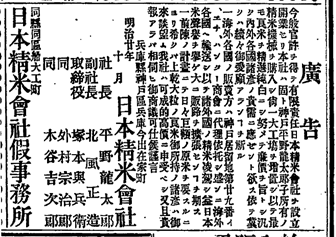6. Japanese spirit, Western technology (part 2)
In the decade before and after 1890, a major issue in Japanese diplomacy was the amendment of unequal treaties. The resident of the Kobe Foreign Settlement enjoying the greatest trade volume and trust was E.H. Hunter. He suppressed opposition within the settlement, insisting, "We owe our profits to the state and the people of Japan," and, "To offend those people is the surest way to invite a loss for ourselves."(1) Evidently, he had a strong say. In 1894, Japan amended its treaty with the United Kingdom, realizing its goal and persuading other countries to follow suit.
"Hunter had blended so well into Japan that it no longer mattered whether he was originally British or Japanese."(2) He received much kudos for his unwavering stance, and it is no wonder that his death was lamented: "The loss of one of the wealthiest merchants living in the foreign settlement is regrettable also for Kobe."(3) No doubt Hunter's approach to Japan formed the basis for the trust he earned, and later, combined with his indomitable pioneering spirit, led to his success in business.
With Osaka Iron Works, Hunter invited engineers and introduced machinery from the United Kingdom at the time of opening, and then eventually, as mentioned in the previous episode,(

Hunter also took on the challenge of re-entering into the rice mill business. In 1887, he established Nihon Seimai K.K.(or Nippon Seimai K.K.), installed a German-made rice huller and polisher, and exported the product through the agency of E.H. Hunter & Co. An advertisement that ran in October that year expresses enthusiasm to "outperform the existing polished rice in every foreign country, enhance the reputation of Japanese rice, and significantly expand our market."(4)
Around 1907, Nihon Seimai had succeeded to the point that its "seal impressions were uniquely synonymous with Japanese polished rice in European markets."(5) Further, the polished rice was used by breweries in Japan's leading sake production regions of Nada, Kobe, and Fushimi, Kyoto, creating the opportunity for "substantial innovation in sake rice."(6) In recognition of the contribution to Japan made by the rice mill business, as much as shipbuilding, Hunter received the Order of the Rising Sun, Gold and Silver Rays, in 1909.
Hunter engaged in the brickworks business as well, by investing in Kansai Renga Co., in operation since 1889. He installed Japanese executives and imported brickmaking machines from the United Kingdom through E.H. Hunter & Co. The bricks manufactured were exported "to provide ballast for foreign cargo ships en route primarily to Canada."(7)
Not only did Hunter understand Japanese culture—a foreign culture to his British eyes—but he also respected it. On the one hand, he introduced technologies from the more advanced West, and on the other, he observed the Japanese style of business operation. In this way, Hunter practiced the concept of wakon yosai—Japanese spirit, Western technology.
Bibliography
- 1「居留地会議延期の理由」朝日新聞、明治23(1890)年9月28日、東京朝刊
- 2「成功者の三幅対 –逝けるハンター氏-」朝日新聞、大正6(1917)年6月4日、大阪版
- 3「ハンター氏逝く」神戸又日新報、大正6(1917)年6月4日、
- 4「日本精米会社広告」朝日新聞、明治20(1887)年10月14日、大阪版
- 5副島八十六『開国五十年史付録』 1908~10年、開国五十年史発行所、177p
- 6副島八十六『開国五十年史付録』 1908~10年、開国五十年史発行所 及び酒ミュージアム公益財団法人白鹿記念酒造博物館学芸員大浦和也様のご協力により閲覧させていただいた明治40年辰馬本家の酒造諸費元帳
また、『月桂冠三百六十年史』平成11年6月26日、月桂冠株式会社、191pに関連記載があることもご教授いただきました。感謝申し上げます。 - 7この段落は平山育男『関西煉瓦会社の舞子移転と煉瓦の製造、社章、ハンター商会のかかわりについて』日本建築学会計画系論文集Vol.84 No.7552019.1、日本建築学会、225pを要約させていただきました。感謝申し上げます。
Click here for various inquiries
- 1. Maizuru Maru
- 2. Hunter and Aiko
- 3. E.H. Hunter & Co. at Kobe Foreign Settlement No. 29
- 4. Rokko Maru: Wooden steamship on the "golden route"
- 5. E. H. Hunter, a man with Japanese spirit and Western technology(part 1)
- 6. Japanese spirit, Western technology (part 2)
- 7. Bronze statue of E.H. Hunter (part 1)
- 8. Bronze statue of E.H. Hunter (part 2)
- 9. Temple bell tuned to 122 cycles with Shosoin flute